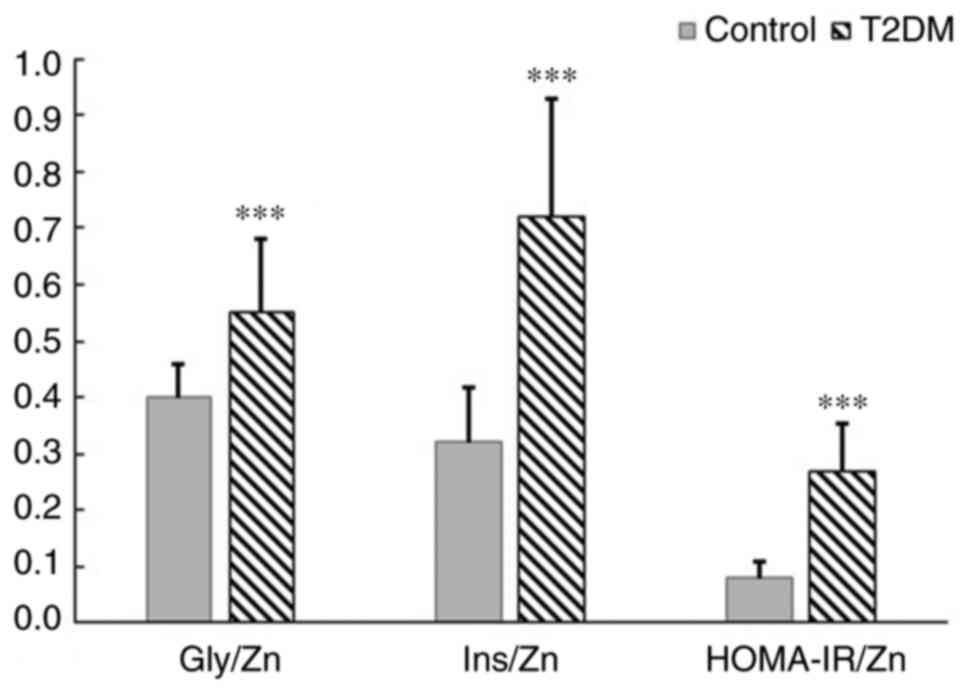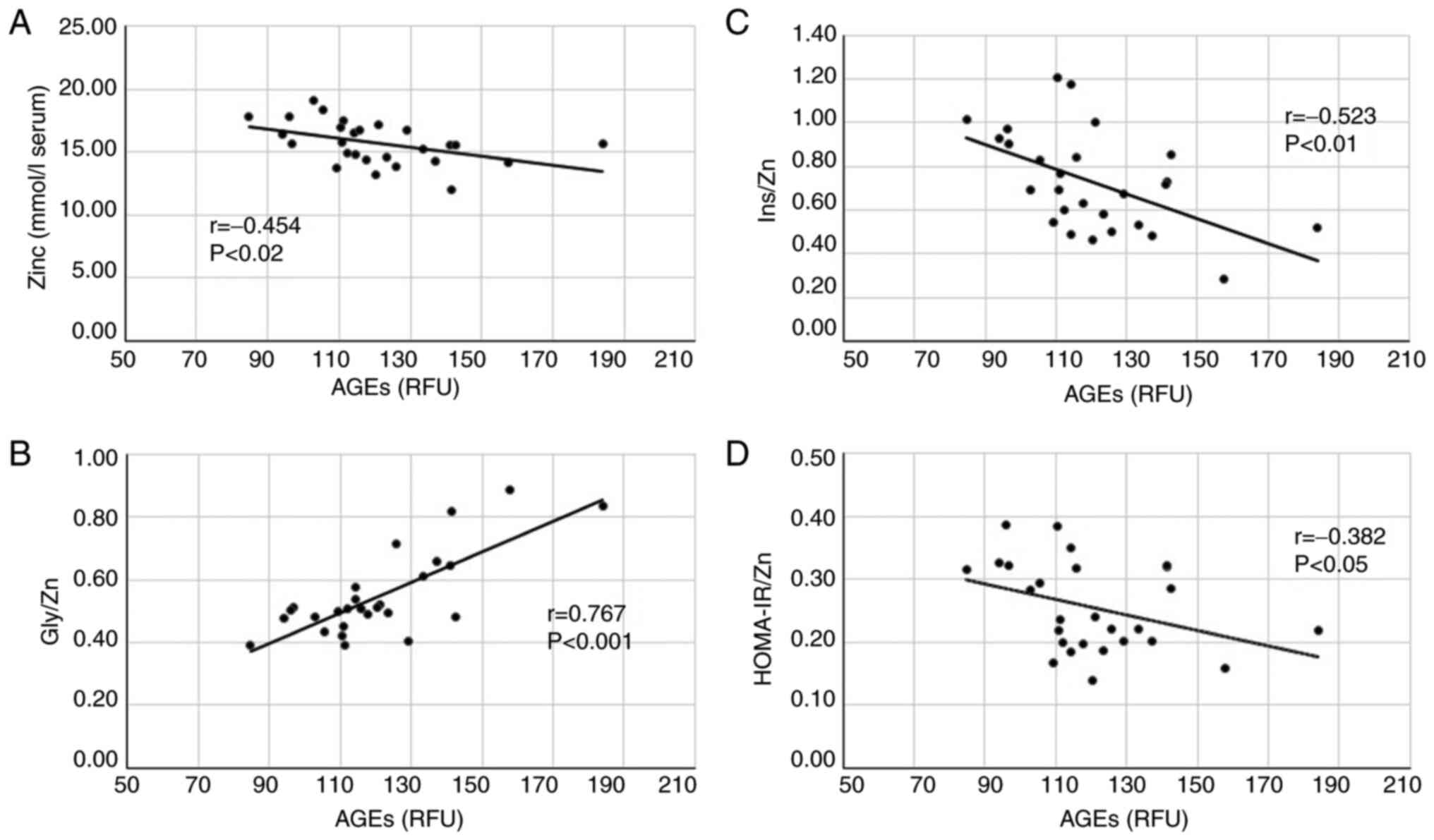|
1
|
Mocchegiani E, Romeo J, Malavolta M,
Costarelli L, Giacconi R, Diaz LE and Marcos A: Zinc: Dietary
intake and impact of supplementation on immune function in elderly.
Age (Dordr). 35:839–860. 2013.PubMed/NCBI View Article : Google Scholar
|
|
2
|
Maret W: Zinc in pancreatic islet biology,
insulin sensitivity, and diabetes. Prev Nutr Food Sci. 22:1–8.
2017.PubMed/NCBI View Article : Google Scholar
|
|
3
|
Huang Q, Du J, Merriman C and Gong Z:
Genetic, functional, and immunological study of ZnT8 in diabetes.
Int J Endocrinol. 2019(1524905)2019.PubMed/NCBI View Article : Google Scholar
|
|
4
|
Giacconi R, Costarelli L, Piacenza F,
Basso A, Rink L, Mariani E, Fulop T, Dedoussis G, Herbein G,
Provinciali M, et al: Main biomarkers associated with age-related
plasma zinc decrease and copper/zinc ratio in healthy elderly from
ZincAge study. Eur J Nutr. 56:2457–2466. 2017.PubMed/NCBI View Article : Google Scholar
|
|
5
|
Malavolta M, Piacenza F, Basso A, Giacconi
R, Costarelli L and Mocchegiani E: Serum copper to zinc ratio:
Relationship with aging and health status. Mech Ageing Dev.
151:93–100. 2015.PubMed/NCBI View Article : Google Scholar
|
|
6
|
Giacconi R, Costarelli L, Piacenza F,
Basso A, Burkle A, Moreno-Villanueva M, Grune T, Weber D, Stuetz W,
Gonos ES, et al: Zinc-induced metallothionein in centenarian
offspring from a large European population: The MARK-AGE Project. J
Gerontol A Biol Sci Med Sci. 73:745–753. 2018.PubMed/NCBI View Article : Google Scholar
|
|
7
|
Giacconi R, Cai L, Costarelli L, Cardelli
M, Malavolta M, Piacenza F and Provinciali M: Implications of
impaired zinc homeostasis in diabetic cardiomyopathy and
nephropathy. Biofactors. 43:770–784. 2017.PubMed/NCBI View Article : Google Scholar
|
|
8
|
Kloubert V and Rink L: Zinc as a
micronutrient and its preventive role of oxidative damage in cells.
Food Funct. 6:3195–3204. 2015.PubMed/NCBI View Article : Google Scholar
|
|
9
|
Skalny AV, Rink L, Ajsuvakova OP, Aschner
M, Gritsenko VA, Alekseenko SI, Svistunov AA, Petrakis D, Spandidos
DA, Aaseth J, et al: Zinc and respiratory tract infections:
Perspectives for COVID19 (Review). Int J Mol Med. 46:17–26.
2020.PubMed/NCBI View Article : Google Scholar
|
|
10
|
Rios-Lugo MJ, Madrigal-Arellano C,
Gaytán-Hernández D, Hernández-Mendoza H and Romero-Guzmán ET:
Association of serum zinc levels in overweight and obesity. Biol
Trace Elem Res. 198:51–57. 2020.PubMed/NCBI View Article : Google Scholar
|
|
11
|
Rajaee E, Mowla K, Ghorbani A,
Dargahi-Malamir M, Zarei M and Rahimikhah FA: The relationship
between serum zinc levels and rheumatoid arthritis activity. Front
Biol. 13:51–55. 2018.
|
|
12
|
Choi S, Liu X and Pan Z: Zinc deficiency
and cellular oxidative stress: Prognostic implications in
cardiovascular diseases. Acta Pharmacol Sin. 39:1120–1132.
2018.PubMed/NCBI View Article : Google Scholar
|
|
13
|
Farhood HB, Balas M, Gradinaru D, Margina
D and Dinischiotu A: Hepatoprotective effects of chlorogenic acid
under hyperglycemic conditions. Rom Biotechnol Lett. 24:301–307.
2019.
|
|
14
|
Farhood HB, Balas MR, Gradinaru D, Margina
D and Dinischiotu A: Effects of chlorogenic acid on the liver cell
metabolism under high glucose conditions. Rom Biotechnol Lett.
24:883–892. 2019.
|
|
15
|
Ungurianu A, Seremet O, Gradinaru D,
Ionescu-Tirgoviste C, Margina D and Danciulescu Miulescu R:
Spectrophotometric versus spectrofluorometric assessment in the
study of the relationships between lipid peroxidation and metabolic
dysregulation. Chem Biol Drug Des. 93:1026–1035. 2019.PubMed/NCBI View Article : Google Scholar
|
|
16
|
Ungurianu A, Margina D, Gradinaru D,
Bacanu C, Ilie M, Tsitsimpikou C, Tsarouhas K, Spandidos DA and
Tsatsakis AM: Lipoprotein redox status evaluation as a marker of
cardiovascular disease risk in patients with inflammatory disease.
Mol Med Rep. 15:256–262. 2017.PubMed/NCBI View Article : Google Scholar
|
|
17
|
Gradinaru D, Borsa C, Ionescu C and
Margina D: Advanced oxidative and glycoxidative protein damage
markers in the elderly with type 2 diabetes. J Proteomics.
92:313–322. 2013.PubMed/NCBI View Article : Google Scholar
|
|
18
|
Margina D, Ilie M and Gradinaru D:
Quercetin and epigallocatechin gallate induce in vitro a
dose-dependent stiffening and hyperpolarizing effect on the cell
membrane of human mononuclear blood cells. Int J Mol Sci.
13:4839–4859. 2012.PubMed/NCBI View Article : Google Scholar
|
|
19
|
Gradinaru D, Margina D and Borsa C: In
vitro studies regarding the antioxidant effects of procaine,
Gerovital H3 and Aslavital. Rev Roum Chim. 54:761–766. 2009.
|
|
20
|
Gradinaru D, Khaddour H, Margina D,
Ungurianu A, Borsa C, Ionescu C, Prada GI, Usher J and Elshimali Y:
Insulin-leptin axis, cardiometabolic risk and oxidative stress in
elderly with metabolic syndrome. Exp Clin Endocrinol Diabetes: Feb
8, 2018. (Epub ahead of print). doi: 10.1055/s-0043-123825
2018.
|
|
21
|
Gradinaru D, Margina D, Borsa C, Ionescu
C, Ilie M, Costache M, Dinischiotu A and Prada GI: Adiponectin:
Possible link between metabolic stress and oxidative stress in the
elderly. Aging Clin Exp Res. 29:621–629. 2017.PubMed/NCBI View Article : Google Scholar
|
|
22
|
Gradinaru D, Margina D, Ilie M, Borsa C,
Ionescu C and Prada GI: Correlation between erythropoietin serum
levels and erythrocyte susceptibility to lipid peroxidation in
elderly with type 2 diabetes. Acta Physiol Hung. 102:400–408.
2015.PubMed/NCBI View Article : Google Scholar
|
|
23
|
Borșa C, Gradinaru D, Margina D, Prada GI
and Pena C: Receptor of advanced glycation end products and
cardiovascular risk in elderly with type 2 diabetes mellitus. J
Biol Res. 90:81–86. 2017.
|
|
24
|
Margina D, Gradinaru D and Mitrea N:
Development of a potentiometric method for the evaluation of redox
status in human serum. Rev Roum Chim. 54:45–48. 2009.
|
|
25
|
Zanfirescu A, Cristea AN, Nitulescu GM,
Velescu BS and Gradinaru D: Chronic monosodium glutamate
administration induced hyperalgesia in mice. Nutrients.
10(1)2017.PubMed/NCBI View Article : Google Scholar
|
|
26
|
Zanfirescu A, Ungurianu A, Tsatsakis AM,
Nitulescu GM, Kouretas D, Veskoukis A, Tsoukalas D, Engin AB,
Aschner M and Margina D: A review of the alleged health hazards of
monosodium glutamate. Compr Rev Food Sci Food Saf. 18:1111–1134.
2019.PubMed/NCBI View Article : Google Scholar
|
|
27
|
Ungurianu A, Seremet O, Gagniuc E, Olaru
OT, Gutu C, Gradinaru D, Ionescu-Tirgoviste C, Margina D and
Danciulescu-Miulescu R: Preclinical and clinical results regarding
the effects of a plant-based antidiabetic formulation versus well
established antidiabetic molecules. Pharmacol Res.
150(104522)2019.PubMed/NCBI View Article : Google Scholar
|
|
28
|
American Diabetes Association. Improving
care and promoting health in populations: Standards of medical care
in diabetes-2020. Diabetes Care. 43 (Suppl 1):S7–S13.
2020.PubMed/NCBI View Article : Google Scholar
|
|
29
|
Matthews DR, Hosker JP, Rudenski AS,
Naylor BA, Treacher DF and Turner RC: Homeostasis model assessment:
Insulin resistance and beta-cell function from fasting plasma
glucose and insulin concentrations in man. Diabetologia.
28:412–419. 1985.PubMed/NCBI View Article : Google Scholar
|
|
30
|
Skalnaya MG, Skalny AV and Tinkov AA:
Serum copper, zinc, and iron levels, and markers of carbohydrate
metabolism in postmenopausal women with prediabetes and type 2
diabetes mellitus. J Trace Elem Med Biol. 43:46–51. 2017.PubMed/NCBI View Article : Google Scholar
|
|
31
|
Bandeira VDS, Pires LV, Hashimoto LL,
Alencar LL, Almondes KGS, Lottenberg SA and Cozzolino SMF:
Association of reduced zinc status with poor glycemic control in
individuals with type 2 diabetes mellitus. J Trace Elem Med Biol.
44:132–136. 2017.PubMed/NCBI View Article : Google Scholar
|
|
32
|
Sobczak AIS, Stefanowicz F, Pitt SJ, Ajjan
RA and Stewart AJ: Total plasma magnesium, zinc, copper and
selenium concentrations in type-I and type-II diabetes. Biometals.
32:123–138. 2019.PubMed/NCBI View Article : Google Scholar
|
|
33
|
Farooq DM, Alamri AF, Alwhahabi BK,
Metwally AM and Kareem KA: The status of zinc in type 2 diabetic
patients and its association with glycemic control. J Family
Community Med. 27:29–36. 2020.PubMed/NCBI View Article : Google Scholar
|
|
34
|
Yin J, Hong X, Ma J, Bu Y and Liu R: Serum
trace elements in patients with polycystic ovary syndrome: A
systematic review and meta-analysis. Front Endocrinol (Lausanne).
11(572384)2020.PubMed/NCBI View Article : Google Scholar
|
|
35
|
Pearsey HM, Henson J, Sargeant JA, Davies
MJ, Khunti K, Suzuki T, Bowden-Davies KA, Cuthbertson DJ and Yates
TE: Zinc-alpha2-glycoprotein, dysglycaemia and insulin resistance:
A systematic review and meta-analysis. Rev Endocr Metab Disord.
21:569–575. 2020.PubMed/NCBI View Article : Google Scholar
|
|
36
|
Capdor J, Foster M, Petocz P and Samman S:
Zinc and glycemic control: A meta-analysis of randomised placebo
controlled supplementation trials in humans. J Trace Elem Med Biol.
27:137–142. 2013.PubMed/NCBI View Article : Google Scholar
|
|
37
|
Vashum KP, McEvoy M, Milton AH, Islam MR,
Hancock S and Attia J: Is serum zinc associated with pancreatic
beta cell function and insulin sensitivity in pre-diabetic and
normal individuals? Findings from the Hunter Community Study. PLoS
One. 9(e83944)2014.PubMed/NCBI View Article : Google Scholar
|
|
38
|
Watada H and Tamura Y: Impaired insulin
clearance as a cause rather than a consequence of insulin
resistance. J Diabetes Investig. 8:723–725. 2017.PubMed/NCBI View Article : Google Scholar
|
|
39
|
Kheirouri S, Alizadeh M and Maleki V: Zinc
against advanced glycation end products. Clin Exp Pharmacol
Physiol. 45:491–498. 2018.PubMed/NCBI View Article : Google Scholar
|
|
40
|
Qu C, Zhou X, Yang G, Li L, Liu H and
Liang Z: The natural logarithm of zinc-α2-glycoprotein/HOMA-IR is a
better predictor of insulin sensitivity than the product of
triglycerides and glucose and the other lipid ratios. Cytokine.
79:96–102. 2016.PubMed/NCBI View Article : Google Scholar
|
















